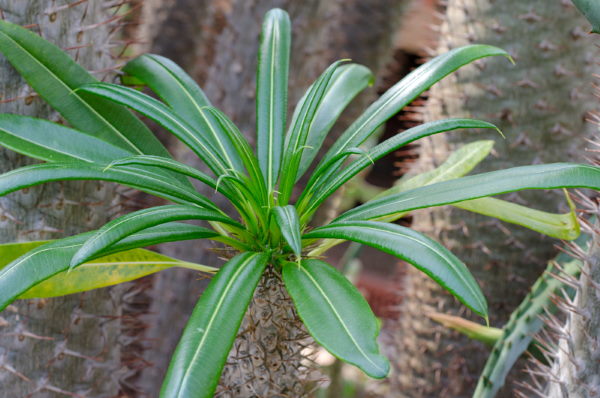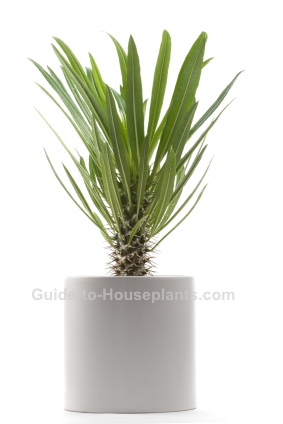Madagascar Palm Care
Madagascar palm is long-lived and easy to please. Known botanically as Pachypodium lamerei, this semi-succulent plant requires very little water, even less in the winter. Just put it the full sun of a west- or south-facing window and it needs little attention to thrive.
 Madagascar Palms grow tall in their native habitat. Photo © Anna Kazantseva
Madagascar Palms grow tall in their native habitat. Photo © Anna KazantsevaGet to Know Your Pachypodium lamerei
This popular Pachypodium has a shiny silver trunk covered with long, sharp spines. The trunk may branch out, making it even more attractive.
A tuft of long, narrow leaves grow only at the top of the trunk, like a palm tree. However, this Madagascar native isn't really a palm but a succulent from the Apocynaceae family.
Did you know...
Pachypodium comes from the Greek pachy meaning thick and podium meaning foot, referring to the thick trunk of this tree.
How big does it get? Madagascar palm will grow up to 6 ft (1.8 m) indoors, much taller if grown outdoors in a frost-free climate.
Does it bloom? Maybe. In the summer, clusters of fragrant, white flowers will appear on mature plants that are grown outdoors. Don't expect it to bloom indoors, unless you can provide plenty of direct sunlight.
You may want to move this sun-loving succulent outdoors to your porch or patio for the summer. Just remember to bring it back inside when the temperature drops -- it won't tolerate frost.
Madagascar Palm Problems, Solutions and Houseplant How-tos
Repot in spring every 3-4 years or when it outgrows its pot. It's a good idea to use a heavy container to prevent toppling. This thick-trunked tree can get top-heavy. Also, be careful of those sharp spines when handling this plant. Wear thick garden gloves and wrap a newspaper or old towel around the trunk while repotting to protect your hands.
Leaf drop in winter is perfectly normal. Madagascar palm may even drop all its leaves. But, don't worry. It'll grow more leaves in spring when it gets the sunshine and warmth it loves. Don't over-water a shedding plant -- that's a sure-fire way to kill Pachypodium lamerei. When the plant comes out of dormancy and you see new leaves growing, that's your cue to resume normal watering and fertilizing.
Something bugging your houseplant? Fortunately, mealybugs are not common on this plant, especially indoors. However, keep an eye out for white, fuzzy specks along the base of the leaves. They're not easy to remove from prickly Pachypodium. You can pry mealybugs off with a stick or long tweezers. Then, treat an infestation with a neem-based insecticide.

Madagascar Palm Care Tips
Light: Full sun
Water: Water thoroughly, then allow the top half of soil to dry out before watering again. In winter, water sparingly just to keep the soil from drying out completely. Plant in a pot with drainage holes to prevent root rot.
Humidity: Average indoor (around 40% relative humidity).
Temperature: Average room temperatures 65-75°F/18-24°C. If you move Madagascar palm outdoors for the summer, don't worry -- it can take the heat. Just bring it back in when the temperature drops; it will tolerate a minimum in winter of 40°F/4°C.
Soil: Cactus potting mix works well to provide fast drainage. Or you can use 2 parts all-purpose potting mix with 1 part horticultural sand or perlite.
Fertilizer: Feed in spring and summer with a cactus/succulent fertilizer.
Propagation: Sow Madagascar palm seeds in spring. Offsets can be cut away from the parent plant and potted up separately.


